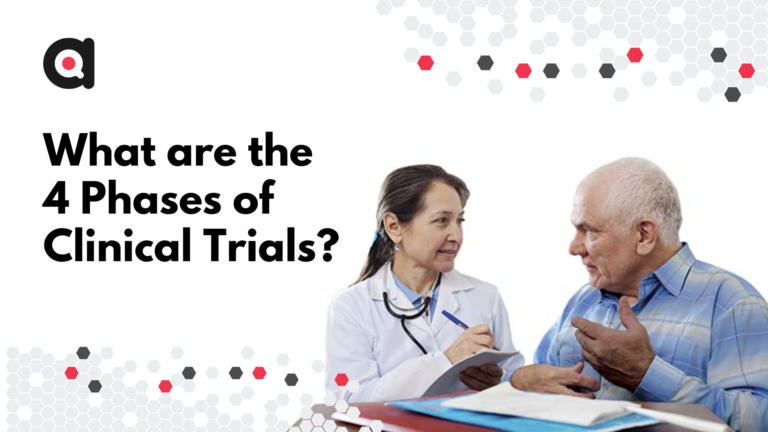What are the 4 Phases of Clinical Trials?
Table of Contents
ToggleAQ

The clinical trial research is divided into four distinct phases, each serving a specific purpose in the pursuit of safe and reliable medicines. These phases constitute a structured journey, guiding investigational products from their initial introduction to thorough evaluation and eventual widespread usage. All of this is effectively planned and executed with the help of a clinical trial management system (CTMS).
Let’s discuss in detail what are the 4 phases of clinical trials.
Phase 1: Safety and Dosage
Phase 1 trials are generally smaller in scale compared to later phases and shorter in duration.
The primary focus of Phase 1 trials is to evaluate the safety profile of the investigational drug or treatment. Researchers may leverage a CTMS to closely monitor participants for any adverse effects, paying attention to potential side effects and their severity. This phase helps determine a safe dosage range for subsequent studies.
Throughout phase 1, clinical researchers study how the drug is absorbed, distributed, metabolized, and excreted in the body (pharmacokinetics) and its impact on the body’s physiological processes (pharmacodynamics). These factors contribute to defining the drug’s optimal dosage and frequency.
This phase often involves a dose-escalation design, starting with a low dose and gradually increasing it to identify the maximum tolerated dose. This step is crucial in understanding how the human body reacts to different levels of the experimental treatment.
Healthy volunteers may also participate in phase 1 clinical trials to establish baseline safety information. This initial evaluation in healthy individuals provides a baseline for comparison when the treatment is later tested in patients with the targeted medical condition.
Remember that ethical oversight in Phase 1 trials is critical. Participants receive detailed information through informed consent, covering risks, benefits, trial purpose, and participant rights. Ethical review boards rigorously scrutinize protocols to ensure safety and adherence to ethical standards.
Phase 2: Efficacy and Side Effects
The primary goals of Phase 2 trials are to further assess the safety and efficacy of the investigational product, gather additional information about its potential benefits and risks, and determine appropriate dosages for the next phase of testing. This is best done with the help of an advanced CTMS.
Phase 2 trials involve a larger group of participants compared to Phase 1, typically ranging from several dozen to a few hundred individuals. Participants are often selected based on specific criteria such as age, health status, and the presence of certain medical conditions.
In this phase, researchers aim to identify the most effective dose with an acceptable safety profile. This involves testing different doses of the investigational product to find the optimal balance between efficacy and side effects.
The majority of Phase 2 trials involve randomization, where participants are assigned randomly to different treatment groups. This helps ensure that the results are unbiased and reflective of the intervention’s true effects. Control groups may be included to compare the investigational product’s effects against a standard treatment or a placebo.
Regulatory interactions continue during this phase, ensuring ongoing communication with authorities to discuss progress, share findings, and seek guidance on the subsequent steps in the development pathway.
All this provides a more in-depth evaluation of the intervention’s effectiveness in treating the targeted condition. Various outcome measures are used to assess efficacy, such as improvements in symptoms, disease progression, or other relevant endpoints. The findings inform decisions on whether to proceed to Phase 3 trials, modify the intervention, or cease development if significant safety concerns arise.
Phase 3: Large-Scale Efficacy
Phase 3 trials are typically more extended than earlier phases, often spanning several months and even years. The extended duration allows for the collection of long-term safety and efficacy data.
This phase involves a significantly larger and more diverse participant population often numbering in the thousands. The primary objective is to provide robust and statistically significant evidence regarding the intervention’s effectiveness and safety across a broader range of patients.
Randomisation and controlled study designs are commonly employed in Phase 3 trials to minimize bias while establishing a clear comparison between the investigational product and standard treatments or placebos. Using a CTMS enables the researchers to complete this phase more effectively.
Continued safety monitoring remains a critical aspect, with adverse events closely tracked to identify any rare or long-term side effects that may not have surfaced in earlier stages.
Positive results from Phase 3 trials form the basis for regulatory submissions seeking approval for the intervention. Comprehensive data on efficacy, safety, and quality are submitted to regulatory authorities for review. Based on the results of Phase 3 trials, sponsors may decide to submit a New Drug Application (NDA) or equivalent regulatory filings for approval. However, it is worth noticing that regulatory agencies carefully review the data before deciding whether to approve the intervention for public use or not.
Phase 4: Post-Launch Monitoring
Phase 4 in clinical research aims to assess the intervention’s real-world effectiveness in a larger and more diverse population than in the controlled environment of clinical trials. This includes patients with comorbidities and demographic characteristics not fully represented in earlier phases.
Researchers may use CTMS to conduct comparative effectiveness studies, comparing the new intervention with existing treatments to understand its relative benefits and limitations in routine clinical practice. Moreover, registry studies may be established to track and collect long-term data on patients using the intervention. These registries contribute to the ongoing understanding of its performance over an extended period.
This may also explore expanded indications or alternative uses for the intervention beyond its initial approval, providing valuable insights into its versatility and potential applications.
Evaluation of health economic outcomes is quite common in Phase 4. This includes assessing the intervention’s cost-effectiveness, impact on healthcare resource utilisation, and overall economic implications.
Findings from Phase 4 trials may lead to updates in product labeling, providing healthcare professionals and patients with the most current information about the intervention’s use and potential risks.
Remember that continuous monitoring in Phase 4 helps maintain a balance between the benefits and risks of the intervention throughout its lifecycle. So, this shouldn’t be compromised by any means.
Bottom Line
All phases of a clinical trial emphasise the careful development of every medical advance. From initial safety checks into real-world effectiveness assessments, this structured process reflects a commitment to precision and patient well-being. It is always recommended to leverage a powerful CTMS, such as AQ Trials to make clinical trial research hassle-free, more precise, and efficient.
Related Articles

Industry News
How to Implement and Use CTMS?
Industry Discussions How to Implement and Use CTMS? AQ The successful implementation and utilisation of a CTMS demand strategic planning and execution backed by ongoing adaptation, feedback loops, and a commitment to leveraging technology for the betterment of medical research. This comprehensive guide will walk you through the key steps involved in implementing and effectively …
AQ

Industry News
The Ultimate Guide to Understanding What is a CTMS
A Clinical Trial Management System (CTMS) is a specialised, all-encompassing project management software tailored to guide a research team from the study’s inception—through the enrolment and oversight phases to the study’s conclusion…
AQ

